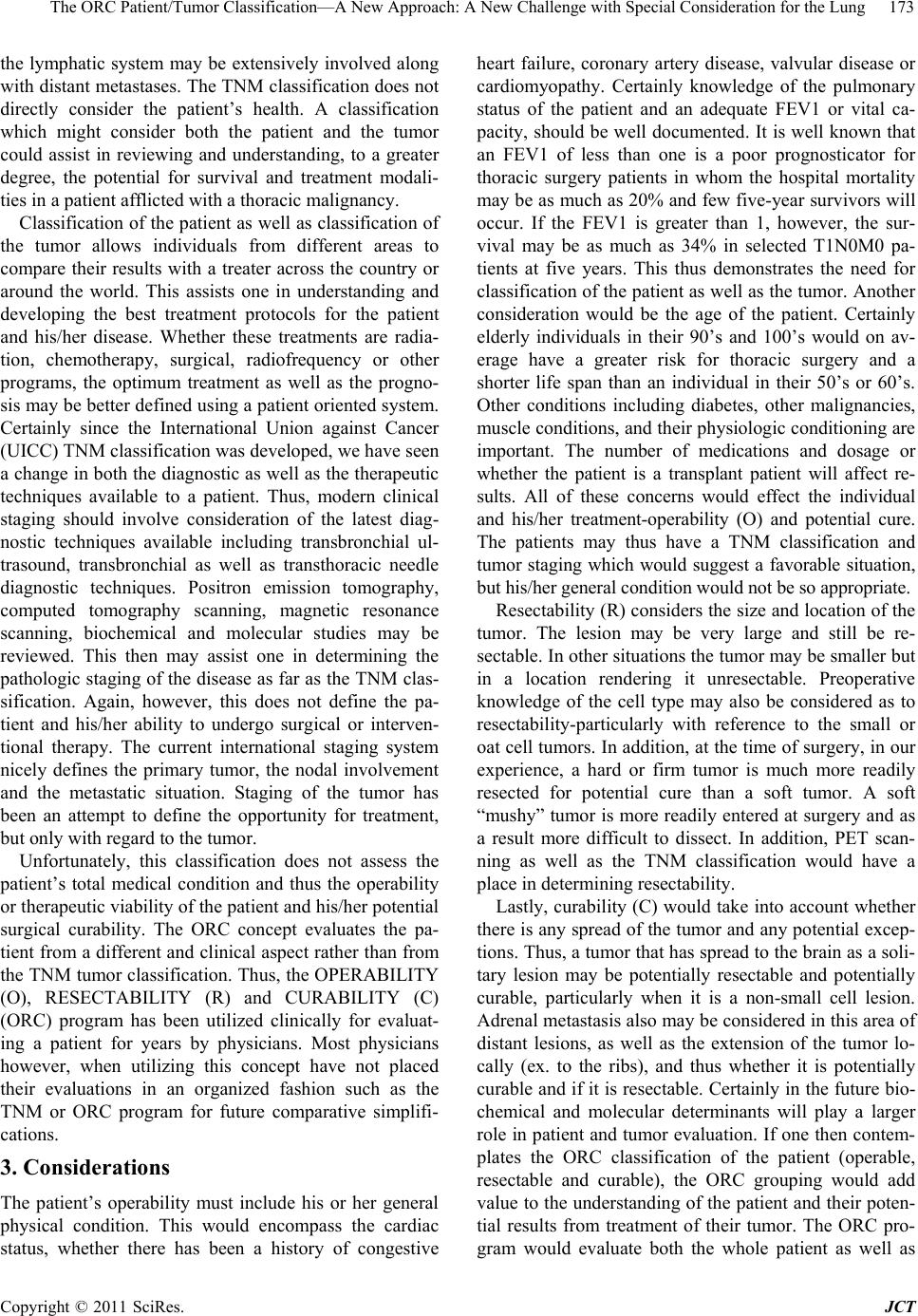
The ORC Patient/Tumor Classification—A New Approach: A New Challenge with Special Consideration for the Lung 173
the lymphatic system may be extensively involved along
with distant metastases. The TNM classification does not
directly consider the patient’s health. A classification
which might consider both the patient and the tumor
could assist in reviewing and understanding, to a greater
degree, the potential for survival and treatment modali-
ties in a patient afflicted with a thoracic malignancy.
Classification of the patient as well as classification of
the tumor allows individuals from different areas to
compare their results with a treater across the country or
around the world. This assists one in understanding and
developing the best treatment protocols for the patient
and his/her disease. Whether these treatments are radia-
tion, chemotherapy, surgical, radiofrequency or other
programs, the optimum treatment as well as the progno-
sis may be better defined using a patient oriented system.
Certainly since the International Union against Cancer
(UICC) TNM classification was developed, we have seen
a change in both the diagnostic as well as the therapeutic
techniques available to a patient. Thus, modern clinical
staging should involve consideration of the latest diag-
nostic techniques available including transbronchial ul-
trasound, transbronchial as well as transthoracic needle
diagnostic techniques. Positron emission tomography,
computed tomography scanning, magnetic resonance
scanning, biochemical and molecular studies may be
reviewed. This then may assist one in determining the
pathologic staging of the disease as far as the TNM clas-
sification. Again, however, this does not define the pa-
tient and his/her ability to undergo surgical or interven-
tional therapy. The current international staging system
nicely defines the primary tumor, the nodal involvement
and the metastatic situation. Staging of the tumor has
been an attempt to define the opportunity for treatment,
but only with regard to the tumor.
Unfortunately, this classification does not assess the
patient’s total medical condition and thus the operability
or therapeutic viability o f the patien t and his/he r potential
surgical curability. The ORC concept evaluates the pa-
tient from a different and clinical aspect rather than from
the TNM tumor classification. Thus, the OPERABILITY
(O), RESECTABILITY (R) and CURABILITY (C)
(ORC) program has been utilized clinically for evaluat-
ing a patient for years by physicians. Most physicians
however, when utilizing this concept have not placed
their evaluations in an organized fashion such as the
TNM or ORC program for future comparative simplifi-
cations.
3. Considerations
The patient’s operability must include his or her general
physical condition. This would encompass the cardiac
status, whether there has been a history of congestive
heart failure, coronary artery disease, valvular disease or
cardiomyopathy. Certainly knowledge of the pulmonary
status of the patient and an adequate FEV1 or vital ca-
pacity, should be well documented. It is well known that
an FEV1 of less than one is a poor prognosticator for
thoracic surgery patients in whom the hospital mortality
may be as much as 20% and few five-year survivors will
occur. If the FEV1 is greater than 1, however, the sur-
vival may be as much as 34% in selected T1N0M0 pa-
tients at five years. This thus demonstrates the need for
classification of the patient as well as the tumor. Another
consideration would be the age of the patient. Certainly
elderly individuals in their 90’s and 100’s would on av-
erage have a greater risk for thoracic surgery and a
shorter life span than an individual in their 50’s or 60’s.
Other conditions including diabetes, other malignancies,
muscle conditions, and their physiologic con ditioning are
important. The number of medications and dosage or
whether the patient is a transplant patient will affect re-
sults. All of these concerns would effect the individual
and his/her treatment-operability (O) and potential cure.
The patients may thus have a TNM classification and
tumor staging which would suggest a favorable situation,
but his/her gene ral condi ti on would not be so appropriate.
Resectability (R) considers the size and location of the
tumor. The lesion may be very large and still be re-
sectable. In other situations the tumor may be smaller but
in a location rendering it unresectable. Preoperative
knowledge of the cell type may also be considered as to
resectability-particularly with reference to the small or
oat cell tumors. In addition, at the time of surgery, in our
experience, a hard or firm tumor is much more readily
resected for potential cure than a soft tumor. A soft
“mushy” tumor is more readily entered at surgery and as
a result more difficult to dissect. In addition, PET scan-
ning as well as the TNM classification would have a
place in determining resectability.
Lastly, curability (C) would take into account whether
there is any spread of the tumor and any poten tial excep-
tions. Thus, a tumor that has spread to the brain as a soli-
tary lesion may be potentially resectable and potentially
curable, particularly when it is a non-small cell lesion.
Adrenal metastasis also may be con sidered in th is area of
distant lesions, as well as the extension of the tumor lo-
cally (ex. to the ribs), and thus whether it is potentially
curable and if it is resectable. Certainly in the future bio-
chemical and molecular determinants will play a larger
role in patient and tumor evaluation. If one then contem-
plates the ORC classification of the patient (operable,
resectable and curable), the ORC grouping would add
value to the understanding of the pa tient and their poten-
tial results from treatment of their tumor. The ORC pro-
gram would evaluate both the whole patient as well as
Copyright © 2011 SciRes. JCT